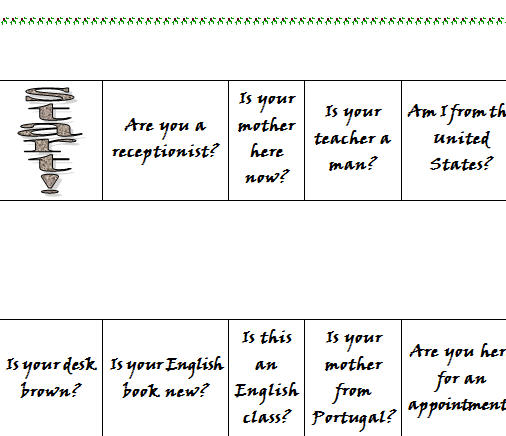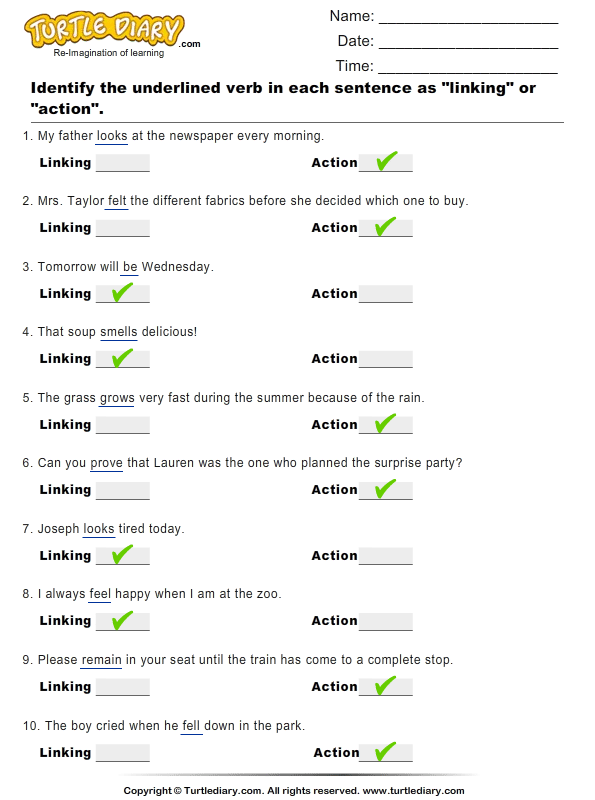Specifically, this type of verb describes a state of being. Moreover, it connects the subject of a sentence with the subject complements. Subject complements are predicate nouns or predicate adjectives.
"To be," "to become," and "to seem" are always linking verbs. Words that can function as a linking or an action verb include smell, appear, look, and sound. A predicate noun, or predicate nominative, is a noun or noun phrase that provides more information about the subject of the sentence.
Let's look at a few examples of predicate nouns in action. In both cases, the main verbs are the action verbs —rewriting and editing, respectively — and the forms of to be simply act as helping verbs. (An industrious bunch!) These sentences do not contain linking verbs and are therefore not relevant for this discussion. You've probably noticed that not all of them behave in the same way within various types of sentences in English. What is the difference between linking and helping verbs?
Verbs are a part of speech that are essential to the construction of a sentence. Without a verb, a sentence cannot be complete. A verb in its basic form, as an action verb, expresses action that is either physical or abstract.
However, there are other types of verbs used in the grammatical makeup of a sentence. Linking and helping verbs are not action verbs, and there is a significant difference in their usage in the English language. In this sentence, 'Carol' is the subject, 'was' is the linking verb and 'tired' is the subject complement.
Other common linking verbs include 'seems' and 'becomes', as well as sensory verbs such as 'feels', 'tastes', 'smells', and 'sounds'. There are three types of verbs; action, linking and helping. Most of the verbs you will use in conversation or writing will be action verbs or linking verbs. Be, seem, look, sound, and more are examples of linking verbs in English.
They are special because they do not involve an action, even though some may be used in a similar way to action verbs. In this grammar lesson, we'll learn how to use these linking verbs in English, in what situations to use them, and how to recognize them when we see them. It may appear difficult, but it's much simpler than it seems. Linking verbs, also called copulas or copula verbs, connect the subject of a sentence with an adjective, noun, or descriptive phrase. To distinguish a copula verb remember that they do not indicate action in a sentence. Rather they describe a state of being, a result, or one of the five senses.
In other words, linking verbs do not have an object. The term "linking verb" refers to a verb that connects the subject of a sentence to information about the subject. Linking verbs do not relay an action but instead link the subject and the other statement details. Perhaps the most common linking verb is to be.
However, there are several other examples, including all verbs that deal with human senses. There are other verbs that can be both linking verbs and action verbs. All of the sense verbs; look, smell, touch, appear, sound, taste, and feel can be linking verbs. Other examples of verbs that can be linking verbs and action verbs include turn, remain, prove, and grow.
What Is Verb Short Answer A linking verb connects a subject to a verb in a sentence in order to show the action that is being done. A linking verb does not express the action by itself. Some words can serve as both linking verbs and action verbs.
Other examples of linking verbs include appear, feel, look, seem, sound, and smell. Depending on how they are used, most of these additional examples can sometimes also be action verbs, which, as the name indicates, describe action. Alas, English has so many ambiguities, and some linking verbs can also function as action verbs. These include all the sense verbs, such as look, touch, smell, appear, feel, sound, and taste.
There are also some outliers, such as turn, grow, remain, and prove. Used as linking verbs, they provide additional information about the subject. The sentences don't tell you what Diane, Clement, Maria, and the music did but rather what they are. Linking verbs "link" their subjects to a classification, state of being, or quality. In the sentences above, happy, feverish, doctor, and good are called complements of the linking verbs. The next time you write something, circle every linking verb you can find in the document.
If you see many of them, you may want to rewrite some of the sentences and substitute some action verbs. Replacing just a few linking verbs with their more active counterparts can transform a page of writing. When you write, you will naturally need to use both linking and action verbs; both verb types play a critical role in the English language. However, the overuse of linking verbs can sometimes leave a piece of writing flat.
Where possible, don't just tell what something is; tell what it does. Sometimes actions or conditions occur only one time and then they're over. It's at times like these that some of the same verbs that are used as auxiliary verbs are instead used as action or linking verbs. This is one of the most common auxiliary verbs, but because it stands alone here, it is not functioning as an auxiliary verb. Now, in this sentence, is is not a linking verb, because there is another verb that is describing what the subject is doing; so, is then is a helping verb. Now, a helping verb, which you may have also heard called an auxiliary verb, is exactly what it sounds like.
It helps the main verb of a sentence by giving more insight into the portrayal of time. Another way of saying this is that it helps the main verb form the proper tense. The verbs appear, become, feel, get, grow, look, remain, seem, smell, sound, stay, taste, and turn can act either as action verbs or linking verbs.
Additionally, the verbs remain, grow, turn, and prove can function as both action verbs and linking verbs. When you use one of these words as a linking verb, it provides information about the subject of the sentence. Hello, welcome to another test- quiz of English Grammar.
This time it focuses explicitly on Linking Verbs. A linking verb helps to connect a subject to a specific word that describes that subject. For each sentence, choose the correct linking verb.
Because linking verbs neither describe actions nor require an object to complete their meaning, they are categorized as intransitive verbs. There are other verbs that are sometimes linking verbs and sometimes action verbs. These include grow, prove, look, smell, sound, taste, turn, feel, remain, stay, and appear. According to traditional English grammar guides, a linking verb describes the subject by connecting it with the rest of a sentence.
What's more, they can be a single word or a group of words. Unlike other verbs, this type of verb does not convey action. Think of them as the glue that holds a sentence together. Linking verb connects a descriptive noun or adjective to the subject, while an action verb describes the action being performed by the subject. A linking verb is a verb that describes the subject. Linking verbs connect the subject to a predicate noun or a predicate adjective.
Linking verbs do not describe any direct physical or mental action of the subject or any action controlled by the subject. An easy way to differentiate them is to replace the verb in question with a verb form of be. If the sentence doesn't make sense any more, then it is an action verb; if the sentence is still meaningful, it's a linking verb. That subject complement can be an adjective, a noun, a pronoun, or a possessive. The verb be is perhaps the most common linking verb.
A few frequent others are become, seem, look, taste, feel, and appear. The most common linking verbs are become, seem, and any form of the verb be (including am, is, are, was, were, etc.). These verbs are called true linking verbs because they are always linking verbs. Because linking verbs and auxiliary verbs are often the same words, you may wonder how you can tell the difference between a linking verb and an auxiliary verb.
The subject complement can take a variety of different forms. Let's look at some sentences that use linking verbs to show what subject complements can look like. Linking verbs operate differently than action verbs. First, while action verbs are modified by adverbs, linking verbs are often followed by adjectives.
Now's the time to practice what you have learned so far. See if you can identify which words in the following sentences are thesubject, thelinking verb, and what thesubject complementis. There are 23 total linking verbs in the English language. This total is made up of about eight verbs that are always linking.
Examples include become, seem, and any form of the verb to be like am, is, are, was, were, and has been. Additionally, this total includes about 15 more verbs that can also be action or helping verbs. Adding linking verbs to your writing is important for a sentence to make sense. To learn more about this type of verb and its usage, read all about linking verbs. Get the basics of what they are and how to identify them.
A linking verb shows the relationship between the subject and the complement of a sentence. The two sentences illustrate how the use of an action verb can enliven a sentence. The point is not that the sentence Mark is tall is deficient; in fact, depending on the context, it could work perfectly well.
However, the choice between is and a more active alternative becomes important when linking verbs appear in abundance in a piece of writing. Other examples of action verbs include repair, arrive, audit, testify, rotate, and brainstorm. These, as well as most other action verbs, can't double as linking verbs. Although a linking verb serves a useful function by identifying or describing the subject, it lacks action.
Its overuse can lead to wordiness and monotony in writing. Therefore, it is crucial to formulate a linking verbs list. We receive many requests from individuals who seek help with identifying verbs.
A lot of individuals get linking verbs confused with helping verbs. Hopefully the following information will help you properly identify verbs. When a linking verb works in this way, the subject complement will be an adjective or an adjective phrase. You must be careful when using adverbs with linking verbs. Linking verbs do not refer to actions, so using an adverb may change the meaning of your sentence. For example, the sentences The boy looked weak to me and The boy looked weakly to me have two different meanings.
Linking verbs can function as intransitive verbs, which do not take direct objects. The presence of a direct object in a sentence/clause will alert you that the verb used with it is not a linking verb. The following sentences all use linking verbs.
In order to tell if a verb is being used as a linking verb, look if the sentence has a subject complement. Remember, linking verbs are used to link information so there must be a subject complement that is describing or identifying a subject. To know more about linking verbs, we need to talk about action verbs.


























No comments:
Post a Comment
Note: Only a member of this blog may post a comment.